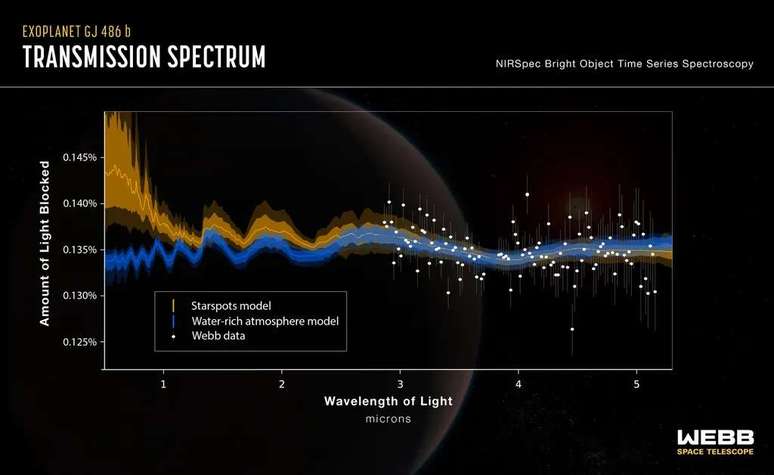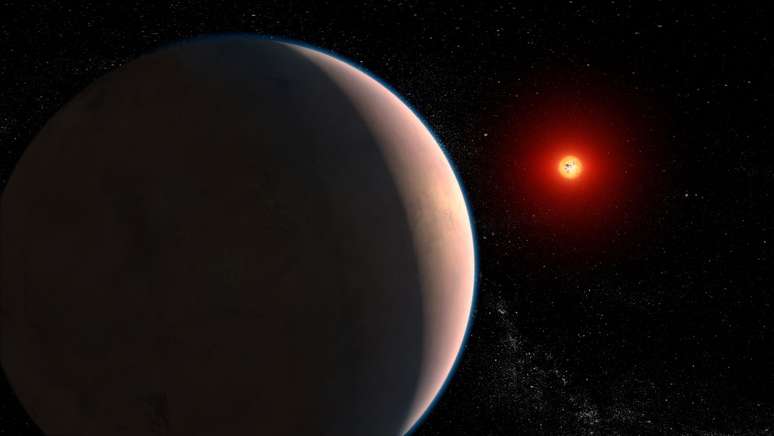James Webb has detected a signal of water vapor that could belong to the atmosphere of a rocky planet, slightly larger than Earth, orbiting a red dwarf.
Perhaps astronomers have found an atmosphere on a rocky exoplanet for the first time. The James Webb Telescope has found water vapor in a star system very close to Earth, possibly on a planet 30% larger than Earth and three times as massive.
- An Earth-sized exoplanet could have a magnetic field and produce auroras
- Planets can save themselves from hostile stars by hiding water in rocks
Located just 26 light-years from Earth, GJ 486 is a red dwarf, a type of star with a mass and temperature lower than that of the Sun. This is the most common type of star in the Milky Way, so scientists are trying to find out if the planets around them could harbor life.
There is still some debate about the atmospheric conditions of worlds orbiting red dwarfs because they are very active. Due to the low temperature, the planets have to be very close to these stars to keep the water in a liquid state, which means more radiation from stellar explosions.
Scientists have yet to find concrete signs of an atmosphere on rocky exoplanets (worlds orbiting stars other than the Sun) discovered so far, but GJ 486 b could be the first, which would be a huge step forward in the search for potentially habitable worlds. .
With a surface temperature of around 430 degrees Celsius, the planet is so close to the star that it completes an orbit in just 1.5 Earth days. However, Webb’s near-infrared spectrograph (NIRSpec) shows traces of water vapour. The problem is that scientists don’t yet know whether this vapor comes from the planet or from the star itself.
If water vapor is associated with the planet, it means it has an atmosphere and perhaps that means conditions to support some form of life. The team of scientists behind the study observed two transits, i.e. two “laps” of the planet around the red dwarf, using three different methods to analyze the resulting data.

Since the object seems to have a “locked” orbit, like the Moon with respect to the Earth, we always see only one of the faces of our natural satellite. This makes the GJ 48 a type of planet nicknamed “eyeball”. Observing the planet only when it passed in front of the star, the researchers only saw the night side, that is, the side that is constantly away from the light of its star.
The results of all three methods yielded the same results, so the researchers ran computer models to determine which molecules might form the signals Webb detected. Therefore, they concluded that the chemical signature is most likely to be water vapour.
The team warns that this vapor could also come from the red dwarf rather than the planet. This also happens with the Sun, when sunspots appear, much cooler than the rest of the solar surface. The star GJ 486 is much cooler than the Sun, so even more water vapor could be “rising” into its star spots.
To find out which of the two objects the vapor is related to, further studies will be needed, especially on the day side of the planet. For this, the team intends to use the Mid-Infrared Instrument (MIRI), another instrument from James Webb.
The article describing the find was published in the journal The letters from the astrophysicist diary.
Source: The letters from the astrophysicist diary, NASA
Trending on Canaltech:
- Why do hospitals give gelatin to patients?
- The quest for human longevity is over, scientists say
- El Niño could hit strongly in 2023. Find out how it can affect Brazil
- The robot “passes out” after working himself to exhaustion – and there’s a video of it
- ChatGPT costs more than BRL 3.5 million per day to operate, analyst says
- 5 reasons NOT to buy the Chevrolet Onix RS
Source: Terra
Rose James is a Gossipify movie and series reviewer known for her in-depth analysis and unique perspective on the latest releases. With a background in film studies, she provides engaging and informative reviews, and keeps readers up to date with industry trends and emerging talents.







